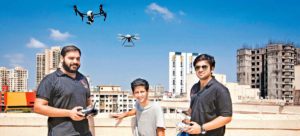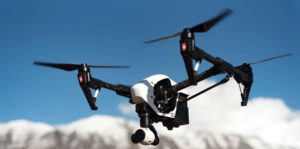Quidich’s drones captures crucial data for industrial clients, with the primary goal of enabling better decision-making for their clients

Finding survivors under debris; surveying power transmission assets to calculate damage and loss; collecting data in remote and inaccessible areas, helping the nation’s armed forces save lives and more. These are examples of activities that attract industrial clients towards unmanned aerial vehicles (UAV) or drones. When Rahat Kulshreshtha, a film maker and Gaurav Mehta, a mechanical engineer and an accomplished car racer, understood the market potential of these drones and set up Quidich in 2013, this technology was at a nascent stage. The duo did the Young India Fellowship in New Delhi and their interest in drone technology brought them together to set up the company.
“We started with a simple plan – to understand the problems in large industries and use drone technology with a combination of hardware and software to solve it,” recalls Mehta, co-founder of Quidich, a company that uses UAV to get an aerial perspective of a particular process for a company and then aid the company in making business decisions.
The company first started its business by offering its solution to cinematography clients and helped them get better aerial shots instead of hiring helicopters and mounting cameras in difficult locations. “Our drones captured far more stunning shots and that too at a fraction of a cost,” says Mehta, about serving the film segment.
However, after the duo spotted the opportunity to use the same technology to solve more critical problems for oil & gas companies, telecom and power grid inspections, mining inspections and such, it started serving the industrial segment. The idea was data from aerial view of a drone, can help make industrial companies make all-important, crucial business decisions with data, rather than gut feel. “We, sort of, became a part of their digitization projects,” adds Mehta.
Quidich has come a long way since its inception. It has 22 in-house drones and has executed more than 350 projects successfully. It has 75 individual clients, and has completed more than 30 projects internationally and has forged key partnerships with large international hardware and software companies.
Quidich also wants to create organized systems and processes around capturing and using drone data, with visualisation features. The end goal, of course, is to enable swift decision making that improves business effectiveness and impacts the top and/or bottom-line positively
![]()
Creating the right model
The founders were clear that they didn’t want to drive the price down when they started the business and wanted to make money right from the beginning. Hence, when it started with the cinematography sector, it set the pricing in India, as there was no one else doing it in an organised manner. “Our profit margin was good and we reinvested it to acquire customers and build solutions,” says the founder.
After they started the business, the co-founders understood the importance of the data that was captured by the drones and realised that the enterprises needed actionable insights using this data, rather than the data itself. Therefore, the company added a data analytics layer to its operations and got clear mandates from clients, with a pricing model based on the final outcome of decisions made based on data.
To quote a few sample projects, Quidich worked with one particular state government to build an end-to-end, last mile integrated surveillance solution for the police force. The drones they supplied are currently being used for surveillance at large crowd gatherings, convoy tracking, amongst other use cases. In its project for Rail Vikas Nigam Limited drones were used to assess roadblocks, track critical rail assets and monitor construction progress in a conflict ridden areas.
It has also worked with various security forces such as the CRPF, BSF and the Army, where it provides drones for insurgency detection combining visual and thermal sensors, allowing night time tracking of targets. With track length of over 100,000 kms, the Indian Railways has employed Quidich drones across the country to monitor progress. The company has also added a new dimension to the live broadcast at IPL 2015 where it streamed HD video from the sky straight to TV sets all over the world.
The company has been successful in growing its business through internal accruals. It has not raised external funds so far but is gearing up to close its first round shortly.
Not without challenges
But all these come with its own set of challenges that span across the spectrum. For instance, Mehta recalls, “We had no background and understanding of how businesses work, but we’ve learned things the hard way, through experience and making mistakes. And regulatory factors were a major concern as there are no specific regulations in India for this business.” However, the company got over this by getting permission and NOCs from multiple authorities like the DGCA, MHA, AAI and local authorities, for specific client projects.
This apart, when the business was incorporated, the market was not very aware of UAVs. And hence, the duo had to spend a lot of time educating their customers. But, today, things have changed and the users are very clear about what they want from drones.
Talent acquisition is another major challenge. “You need to get someone on board and take them through the entire process from scratch,” says Mehta.

The growth path
Going forward, the company aims to establish a strong presence in four verticals: security and surveillance solutions; corridor, terrain asset inspections; vertical asset inspections; and cinematography. Quidich also wants to create organized systems and processes around capturing and using drone data, with visualisation features. The end goal, of course, is to enable swift decision making that improves business effectiveness and impacts the top and/or bottom-line positively.
On a concluding note, Mehta simply says, “Climbing telecom towers or windmills to gather data will be unheard of, from now on. Drones will go where humans need not go.”
The Plan
Understand problems in the industrial context and use drone technology to tackle these challenges. Think railway asset tracking; oil & gas assessments, aerial survey of telecom towers, etc
Implementation
The central idea is to gather data using drones, without the need to deploy humans. For example, Quidich worked with one state government to build an end-to-end, last mile integrated surveillance solution for the police force – surveillance at large crowd gatherings, convoy tracking, etc. In its project for Rail Vikas Nigam Limited drones were used to assess roadblocks, track critical rail assets and monitor construction progress in a conflict ridden areas.
Key Highlights:
- Quidich was incorporated in 2013 by Rahat Kulshreshtha, a film maker and Gaurav Mehta, a mechanical engineer and an accomplished car racer
- The company uses Unmanned Aerial Vehicles to get an aerial perspective of a particular process for a company that aid in better business decisions
- It caters to companies from the industrial sector, defence forces and cinematography
- Uses visual data and digitisation and give corporate better quality information
- Outcome-based pricing model in certain cases
- Worked with corporates like L&T, Adani Power, RVNL, Indian Railways, Government of Rajasthan, CRPF, BSF and so on.
Snapshot: Quidich
Year: 2013
Headquarters: Mumbai
Founder: Rahat Kulshreshtha and Gaurav Mehta
Funding: Self- funded

